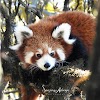The red panda has reddish-brown fur, a long, shaggy tail, and a waddling gait due to its shorter front legs; it is roughly the size of a domestic cat, though with a longer body, and is somewhat heavier. It is arboreal and feeds mainly on bamboo, but also eats eggs, birds, and insects. It is a solitary animal, mainly active from dusk to dawn, and is largely sedentary during the day. It is also called the lesser panda, the red bear-cat, and the red cat-bear.
Red Panda in Eastern Nepal ( ilam)
Red pandas look more like raccoons and are slightly larger than a domestic house cat (they even have feline-like whiskers), growing to about 50-63cm in length and weighing up to 6kg. They are skillful climbers that, when not foraging on the ground, spend most of their time in the trees curled up with their long, bushy tails wrapped around their heads. A thick reddish-brown fur offers additional protection from the cold, often harsh, mountain weather.
Red Panda In Nepal (Eastern Part)
The red panda is endemic to the temperate forests of the Himalayas, and ranges from the foothills of Eastern Nepal to western Nepal. Pandas are found in Nepal’s Langtang National Park, Annapurna Conservation Area, Sagarmatha National Park, Manaslu Conservation Area, Makalu Barun National Park andKangchenjunga Conservation Area, over 75% of potential red panda habitat falls outside protected areas.
Eastern Nepal holds abundance of birds and mammals diversity. The region is one of the richest part of Nepal in floral and fauna. Maximum area of the region lie within Central Himalayan range and some eastern parts lie in the Eastern Himalayan range; a secure home for globally threatened birds and wildlife. Some districts of eastern Nepal including Ilam, Taplejung and Panchthar holds subtropical and lower temperate forest with maximum rainfall, which are very important habitat for Himalayan Red Panda (Airulus fulgens).
In Panda Search Tour
Red Panda is one of the major attraction for tourist in eastern Nepal. This tour has been one of the exciting tour for us. Five nights stay in high hills was very productive in many aspects. The first day of the trek; we had wonderful view of magnificent Red Panda family; mother with two juvenile cubs. Second day we collected full bucket of colorful Himalayan birds including the fascinating male Satyr Tragopan Tragopan satyra, flock of skulking Brown Parrotbill Cholornis unicolor, beautiful Golden-breasted Fulvetta Lioparus chrysotis, noisy Great Barbet Psilopogon virens, very shy Rufous-breasted Bush-robin Tarsiger hyperythrus, highly gregarious Black-throated Thrush Turdus atrogularis, an endemic to central Himalayas Hoary-throated Barwing Sibia nipalensis, Three different species of Yuhina; Stripe-throated Yuhina gularis, Whiskered Y. flavicollis, Rufous-vented Y. occipitalis, and different varieties of tits and some skittish warblers. On third day we again encountered with the same Panda family of the first day with better weather and lights. Fourth day we luckily get close distance view of another family consisting one mother and two juveniles. The fourth day has quite interesting story, we sent our all four trackers to different locations and waited for one hour taking sunbath on open slope of the hill, suddenly Dinesh noticed some movement in distance and slowly moved forward and did scan around the area and whispered us to take camera with us. We followed him and he took us to the place. It was very close view of Red Panda in my life. The weather was clear and sunny and Pandas are very close in eye-level height, absolutely a splendid view! Last day we had good morning walk in warm sunshine around the village. The morning walk was very productive in birding aspect to find out these colorful beauty of Himalayas: Dark-breasted Rosefinch Procarduelis nipalensis, Maroon-backed Accentor Prunella immaculata, Little Bunting Emberiza pusilla, Blue-fronted Redstart Phoenicurus frontalis, White-collared Blackbird Turdus albocinctus, Golden-throated Barbet Psilopogon franklinii were major attractions including varieties of sunbirds, tits and warblers.
Why the Red Panda is endangered ?
The word panda comes from the Nepalese “poonya” which means bamboo eater. While the giant panda is sometime called the black and white cat-foot, the red panda is known as the red cat bear or lesser panda. While it may be “lesser” in size than the giant panda, both species are threatened by less habitat and deforestation. An increase in human population, particularly in China and Nepal, has seen the red panda’s bamboo forest homes cut down and cleared for timber, fuel and agriculture land, pushing them to more remote, fragmented – and often unprotected – mountain areas.
It is listed as Endangered on the IUCN Red List because the wild population is estimated at fewer than 10,000 mature individuals and continues to decline due to habitat loss and fragmentation, poaching, and inbreeding depression.






0 Comments